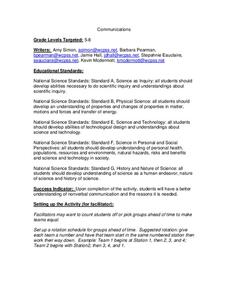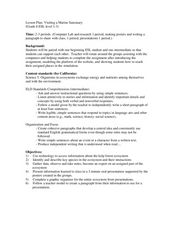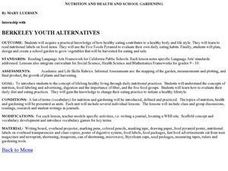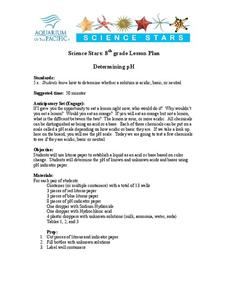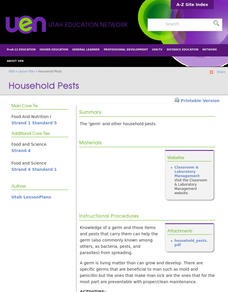Curated OER
Composition
Ninth graders, while looking and examining a photograph provided to them, write a composition that exemplifies the photograph with at least three of the five composition rules illustrated with 100% accuracy. The composition is the start...
Curated OER
Depicting Women and Class in a Global Society
Students explore visual arts that feature women. In this women in art lesson, students analyze "Marquise de Miramon, née Thérèse Feuillant" by Jacques Joseph Tissot and "The Milliners" by Edgar Germain Hilaire Degas. Students compare how...
Curated OER
Communications
Students incorporate different disciplines into this lesson. In this science lesson, students investigate the use of communicating without words, and how it is different than communicating with words. They discuss the pros and cons of...
Curated OER
Visiting a Marine Sanctuary
Students gather information on a kelp forest and identify species in that ecosystem. In this underwater ecosystem lesson students gather data, give an oral presentation and create a poster.
Curated OER
RESPONSIBILITIES OF OFFICE
Students make an organizational chart. They show the relationship of power in the executive branch of the Illinois state government. They include the responsibilities of each office and define the roles and responsibilities of top...
Curated OER
Scientist Tracking Network
Young scholars correlate surface radiation with mean surface temperature of several geographic regions. They observe how these parameters change with latitude and construct an understanding of the relationship of solar radiation to...
Curated OER
Simple Machines
Students investigate simple machines. In this simple machines lesson plan, students construct two simple machines and describe what they do. Students show that simple changes help machines do work with less effort. Students use a paper...
Curated OER
Trends Forecasting
Learners practice trends forecasting to predict the weather. In this forecasting lesson plan, students learn how meteorologists predict the weather by looking at weather trends. They then predict their own forecast, analyze the results,...
Curated OER
Analog Forecasting
Students recognize the elements of an analog weather forecast. In this weather forecasting lesson, students use a website and look for trends, persistence and climatology in weather forecasting. Students complete a...
Curated OER
Elders' Weather Forecasting
Learners interview an Elder to determine ways of forecasting the weather. In this weather lesson, students use the information from an interview to make a weather prediction.
Curated OER
Soil Permeability
Students discuss how soil permeability is affected by permafrost. In this soil lesson plan, students freeze soil over night, and discuss how the environmental conditions of freezing affect soil and further affect vegetation.
Curated OER
DIVISION OF LABOR
Students define division of labor. They read books about how things are produced to help illustrate the concept of division of labor. They suggest other items that could illustrate division of labor. They create a sample flow chart...
Curated OER
Climate Change
Ninth graders compare the Arctic and Antarctic. In this climate lesson students work in groups, research and complete an oral report or a poster.
Curated OER
Nutrition and Health and School Gardening
Students examine how healthy eating contributes to a healthy body and life style. They read nutritional labels on food items. They use the Five Foods Pyramid to evaluate their own eating habits. They plan, design, and create a school...
Curated OER
Differential Thermal Calorimetry
Students access prior knowledge of infrared rays, ultraviolet rays, gamma rays, x-rays and cosmic waves. In this electromagnetic waves lesson, students hold a mock trial electromagnetic spectrum. Students present characteristics of the...
Curated OER
Plotting Earthquakes
Students explore earthquakes. Using the National Earthquake Information Center website, students plot daily earthquakes on a map. They observe the magnitude of each earthquake. Students identify the pattern of earthquake locations and...
Curated OER
Clouds
Students explore clouds. In this weather lesson, students identify the steps in the water cycle, define condensation and evaporation, and relate this information to cloud formation. Students perform a cloud experiment,...
Curated OER
Explore More About Bottle Construction
Students explore Green Construction. For this lesson based on the experiences of Peace Corps volunteers, students gain insight into alternative construction in Guatemala. They examine the pros and cons of using alternative building...
Curated OER
Draw an Alien in Natural Habitat
Students apply prior knowledge of living things, structures of living things and how living things sense and respond to their environment. In this habitat instructional activity, students review the basic needs of organisms to survive....
Curated OER
Barging Along
Students create a barge. In this technological design lesson, students use modeling clay to create a barge to hold marbles. Students make their barge then test it to see how many marbles it will hold. Students discuss why their design...
Curated OER
The Solar System
Third graders investigate Newton's law of Motion. In this chemical reaction lesson, 3rd graders participate in an experiment with rockets to study Newton's law. Students observe the effects of a chemical reaction made by combining...
Curated OER
Determining pH
Eighth graders explain the difference between acids, bases and neutral solutions. In this chemistry instructional activity, 8th graders describe the properties of each. They determine the pH of an unknown solution using the indicator...
Curated OER
Utah's Harvest
Fourth graders recognize the importance of the physical geography on a community. In this commodities lesson, 4th graders graph the five most important commodities of Utah. Students understand why these commodities are so...
Curated OER
Household Pests
Identify methods that prevent food-borne illnesses and contamination. National Standard 14.4.1 Identify food-borne illness Identify types of food-borne illness and their symptoms: botulism, e-coli, hepatitis, salmonella, staphylococci...
Other popular searches
- 5 E Science
- 5 Minute Science Experiments
- 5 E Science Magnets
- 5 E Science Lessons
- 5 E Lesson Plans for Science
- 5 E Science Forces
- 5 E Lesson Plans Science
- 5 E Life Science
- Science 5 E Model
- 5 E Model Science
- 5 E for Science
- Science 5 E Model


